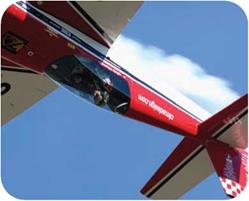Aerobatics Today
Modern aerobatic aircraft can perform maneuvers impossible for an ordinary airplane, such as torque rolls (rolling and sliding backward at the same time) or lomcevaks (tumbling end over end). Aerobatic
О The U. S. Navy’s Blue Angels, using F/A-18 Hornets, perform aerobatic movements at an air show in 2006.
planes are strong but very light in relation to the power of their engines. Most use piston engines and propellers.
One outstanding aerobatic airplane is the U. S. Pitts Special. The first Pitts flew in 1947, and since then Pitts Specials have dominated aerobatic competitions. The later versions of this little plane remain close to the original design.
Formation teams perform their displays with as many as sixteen aircraft, although a team of nine or ten is more usual. During a per-formance, aircraft change formations a number of times. They split up into smaller groups, following the instructions of the team leader by radio. Pilots often use colored smoke trails to highlight the patterns they are flying.
Famous aerobatic teams include the Blue Angels of the U. S. Navy, the Thunderbirds of the U. S. Air Force, and the Red Arrows of the British Royal Air Force. Unlike other aerobatic performers, military teams usually fly jet planes. These planes fly faster than propeller planes and need more space to display their formations. The Thunderbirds fly the F-16 Fighting Falcon that has a top speed of 1,300 miles per hour (2,092 kilometers per hour).
Accidents are rare, but aerobatics are demanding. Pilots practice constantly to perfect new formations and sequences. They also must keep physically fit to cope with the stress of aerobatics, which subjects their bodies to strong g-forces (acceleration measured as multiples of the force of gravity at Earth’s surface).
—
PATTY WAGSTAFF
Born in 1951 in St. Louis, Missouri, Patty Wagstaff flew with the U. S. aerobatics team from 1985 to 1996. She was the first female U. S. National Aerobatic champion, a title she won three times. Wagstaff was International Aerobatic champion in 1993. In 2004, she was elected to the National Aviation Hall of Fame. The Goodrich Extra 260 plane flown by Patty Wagstaff in the 1990s is displayed at the Smithsonian Institution’s National Air and Space Museum. Wagstaff has flown at air shows all over the world and says she likes the precision of aerobatics. "I like flying a perfect loop. . . a perfect maneuver."
|
|
_____________________________________________ /
SEE ALSO:
• Aerodynamics • Barnstorming
• Gravity
_____________________________________________ /











